
Annaberg mill gives visitors a look into past
ST. JOHN, U.S. Virgin Islands — The lack of a single visitor gave the Annaberg Sugar Mill ruins the eerie feeling people expect from historical sites in the middle of the woods, and the kind of reverence it deserves.
Annaberg is a testament of time to when “sugar was king” in the Virgin Islands. Built between 1797 and 1805, the sugar mill was the largest producer of sugar on the island at the time.
| The boiling room was where the “expert sugar cookers” removed the condensed juice from the coppers (Photo by Brook Frazier). | 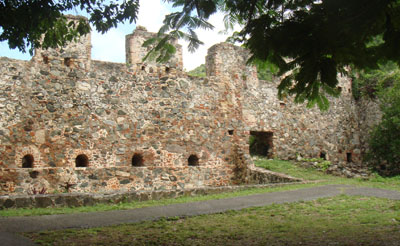 |
The easy, self-guided tour of the mills follows a quarter-mile, counter-clockwise path with informational signs at each site stop.
The sugar mill worked as a small slave community and huge sugar manufacturing site. Enslaved laborers lived side-by-side with their work in the slave village on the hillside of the mill overlooking Leinster Bay across toward the British Virgin Islands.
According to David Knight, the archivist for the St. John Historical Society, “with large labor population such as Annaberg, slave society was as stratified as in any community setting.” In the slave village, the more skilled and ambitious individuals lived in better homes and some even managed to acquire enough wealth to buy their freedom. Others that were “broken by the system,” lived miserably.
“Even a cursory inspection of the remains of the village site reveals a stark contrast in living conditions. Consider the difference between living in one of the substantial stone-foundation structures situated on the well-ventilated high ground near the entry to the factory complex (most likely occupied by skilled laborers, such as coopers, carpenters or sugar cookers), or life in the modest daub and wattle shacks of the common workers down the hill,” said Knight.
On the same hillside, sugar cane was grown. However, hardly a trace remains of either the fields or the homes of the laborers. Piles of stone of former structures are just barely noticeable and the only remaining evidence of their homes.
The first thing visitors notice upon entering the sugar mill ruins is the tower wind-mill. Although it stands in the foreground of all the other structures, it is hard not to notice such a landmark. The Annaberg windmill is, and was, the biggest on the island. It stands 38 feet tall, 34 feet in diameter at the base and 20 feet at the top.
When Annaberg was active, slaves used to keep the operation running. They would bring the harvested sugar cane to the site for processing. The windmill overlooks the entire facility and sits at the end of a piece of overlooking the sea. The view alone would be incentive for anyone to travel this far today.
| The windmill at Annaberg stands above the entire plantation. It was the largest windmill on the island (Photo by Brook Frazier). | 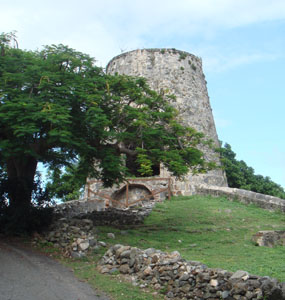 |
When there was not enough wind to keep the windmill churning, the horse mill was used instead. There, oxen, mules or horses were harnessed to long poles that produced the power to crush the sugar cane into juice. Today, none of the actual machinery that made the horse mill or wind-mill run exists, but the structures remain as reminders of how the process worked.
Most of the commotion took place in the boiling house, once the hub of activity at Annaberg. In this room the cane juice was boiled down into a thick syrup that crystallized when cooled into muscavado, a crude brown sugar. The juice boiled in round-bottomed kettles, referred to as coppers, and it was the job of “expert sugar cookers” to remove the condensed juice from them.
Timing was critical; if the juice was left too long it would become molasses instead of sugar. These laborers were the most valued among the workers on the plantation because if the juice was left too long in the copper it would also burn, but removed too early and it would not crystallize. The crystallized sugar was then scraped in to barrels that each held up to 1,600 pounds of muscavado sugar. When it arrived in Europe or North America, it was further processed into the familiar refined white sugar.
“Since considerable time and effort went into the cultivation of the land, harvest, and processing the sugar cane, the sugar cookers’ job was critical to the process and required skill, as well as years of on-the-job training,” Knight said.
With these skills, the end product would not be spoiled. According to Knight, the “worth” of a good sugar cooker is demonstrated in estate records by their high monetary values recoded in mortgage and probate inventories of the period (as slaves, they were periodically appraised along with livestock and other tangible assets).
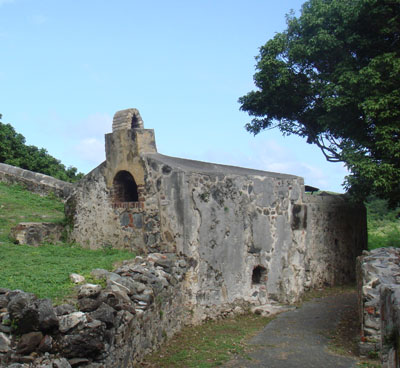 |
The dungeon was used to keep enslaved laborers in line. There were suspicious killings of site overseers when things got too hectic (Photo by Brook Frazier). |
The “heart of rum production” was at the still house. Here, fermentation tanks, known as “butts,” were filled with water, molasses, and other sugar-rich waste products that were collected throughout the sugar-making process. When this mixture was fermented, it was called “mash,” which was then distilled to make rum, the valuable island by-product of sugar.
The mash was put into a still chamber and boiled. The rising steam that resulted from this contained alcohol vapors that were forced into coils of copper tubing, known as “worms,” submerged in a cool water tank, known as the “worm cistern.” As the alcohol cooled in the worms, they became a liquid, known as rum.
Underneath the windmill sits the dungeon. Today it is boarded off to visitors who can only view the grey stone walls at the entrance. When it was first found, a chain and handcuffs were discovered fastened to a post in the corner of the chamber. Tension ran high at the plantation and during the 19th century an overseer was poisoned and another died under suspicious circumstances – the dungeon was used to try to keep slaves under control.
Again, only the most basic parts of the structures remain. None of the machinery of any section of the plantation is in existence. It takes visitors a lot of imagination to picture the ruins as a working entity, producing mass amounts of sugar and rum and full of the noise, smoke, and mechanics of its glory. Luckily the self-guided tour is also equipped with illustrations of how the plantation once looked.
The plantation started with Salomon Zeeger, a Dutch immigrant to the island, who named the property Annaberg, which means “Anna’s Mountain,” in honor of his wife Anna deWindt Zeeger. In 1796 it was an Irish merchant and slave trader, James Murphy, who bought Annaberg and turned it into the vast sugar estate it is now known for. By his death, Murphy was the single largest producer of sugar on St. John, producing 300 to 500 gallons of sugar cane juice in an hour.
As late as 1845, Annaberg’s production level exceeded 100,000 pounds of raw sugar per year, but soil depletion, withering sugar prices, and the emancipation of slave laborers in the Danish West Indies in 1848 almost halted production. The plantation’s sugar crop yielded less than 5,000 pounds of raw sugar in 1861.
After its decline, the plantation was purchased by Thomas Letson who struggled to keep it afloat. But after a hurricane and a series of earthquakes, sugar production at Annaberg came to a permanent end.
| The plantation overseers slept in this room in order to be close to the sugar mill to make sure no one caused trouble (Photo by Brook Frazier). | 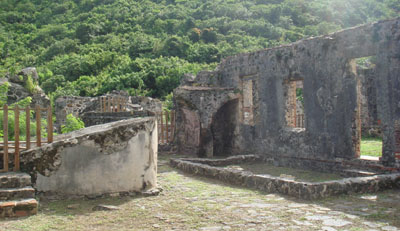 |
The property was then sold to George Francis. Francis, ironically, was born enslaved at the Annaberg plantation and served as a field laborer there when he was 13. Later he gained the position of site overseer and two years after that received outright title to two acres of land on the Annaberg property by his former owner. After Francis’ death, his property was sold and made into crop lands and pasture.
In 1899, it was repurchased by his son, Carl Emanuel Francis. Francis and his family lived among the ruins grazing livestock, growing crops and producing quicklime and charcoal until 1936. Carl Emanuel Francis became a prominent figure on the island, serving as the St. John representative to the Colonial Council, acting as clerk and lay reader to the Nazareth Lutheran Congregation in Cruz Bay and he raised the first United States flag over St. John in 1917.
In 1935, he sold the plantation to Herman O. Creque, who sold it to the Jackson Hole Preserve and Annaberg finally became part of the National Park Service in 1956.
Unlike so many ruins on the island, Annaberg is recognized and receives constant maintenance so that it does not crumble away. Unfortunately, the U.S. Virgin Islands National Park has a 55/100 ranking for its cultural resources. This comes from the State of the Parks Program of the National Parks Conservation Association who assess the condition of natural and cultural resources in parks and determine how well equipped the National Park Service is to protect these parks.
This ranking puts the Virgin Islands National Park in “poor” condition. The park has just one full-time cultural resources staff member, one term curator, and no funds to support research and preservation projects.
The park has identified 400 historic structures, but only 236 of them are currently on the list of classified structures, which means they are officially recognized and protected.
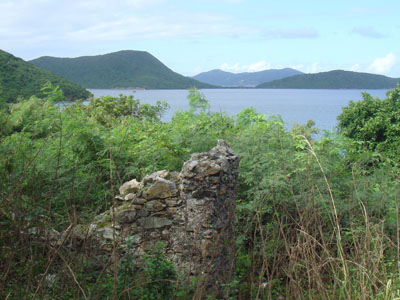 |
Not much is left of what was once the slaves’ homes. It now overlooks the hillside that used to be covered with sugar cane, and across Leinster Bay to the British Virgin Islands (Photo by Brook Frazier). |
Hundreds of historic structures are prone to the dense tropical vegetation that grows around them and as a result crumble away and are reduced to piles of bricks and mortar before they can be properly identified and documented. It’s there that people get an opportunity to discover part of the Dutch heritage that was a big aspect of the island’s past.
If You Go
- Getting there: From Cruz Bay or Cinnamon Bay on St. John, a taxi will take you straight to Annaberg for about $5. Drivers know the site by name. Annaberg is only 10 minutes away from Cinnamon Bay. Getting back requires a quarter-mile walk down the road from the ruins where visitors can then catch a taxi; otherwise you will have to call or request that your driver return for you.
- Activities: There are no entry fees and there are no reservations required. Park cultural demonstrations, including baking “dumb bread” and basket weaving, take place Tuesdays through Fridays from 10 a.m. to 2 p.m.

Comments are Closed